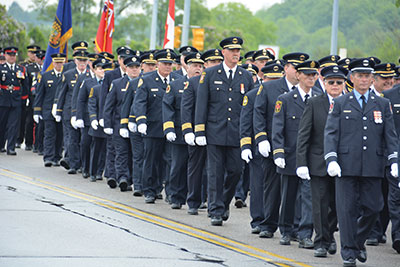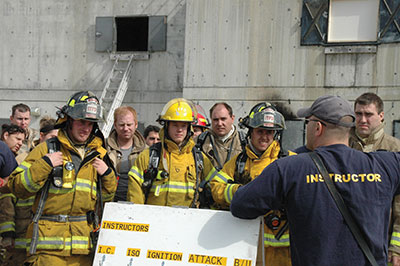
Proving the link
Jay Shaw
Features Health and Wellness WellnessHave you ever wanted to climb to the top of a skyscraper and shout out your message, scream at the moon, or yell at the top of your lungs?
Have you ever wanted to climb to the top of a skyscraper and shout out your message, scream at the moon, or yell at the top of your lungs? Did you happen to see The Onion story about the climate-change scientists who said they just wanted to remind everyone that wind, solar, hydrogen, and other alternative energy sources are ready to go, and have been for a while, but they’re just waiting for consumers to force politicians to come around, listen, and stop our dependency on fossil fuels.
 |
|
| There is plenty of anecdotal evidence, particularly the number funerals for firefighters who have died of cancer, to support a link between fire fighting and cancer, but lawmakers and manufacturers of goods that produce toxins want empirical evidence, which requires funding for studies. Photo by Laura King
|
The Onion, of course, is a satirical publication, but the story triggered social-media conversations about how difficult is it to move ever-so-slightly forward toward green energy and reduce damage to our planet when the answers and solutions have been under our noses for some time.
The situation is the same for firefighters and cancer. If you’ve been on the job for more than a few years, it would almost be impossible for you to not know someone who has died from occupational cancer, yet we’re still trying to prove that the increase in cancer rates for firefighters is caused by exposure to toxins while performing our duties.
I don’t think firefighters need any more proof than the funerals they attend and the plastic, smoldering piles of merged household consumables that form unique shapes, colours, and compounds while they burn, cool and solidify. But these observations are anecdotal and are founded on emotion, and that’s just not the kind of evidence that makes change happen quickly.
The problem is multi-dimensional. First, not all firefighters who contract cancer are treated equally. And although seven of 10 Canadian provinces have presumptive legislation of varying degrees, in P.E.I., Quebec and Newfoundland there are no laws that assume that certain cancers are work-related. What’s more, the presumptive legislation that does exist is not consistent from province to province. While the International Association of Fire Fighters (IAFF) and other groups have been pushing for more thorough and balanced coverage for firefighters who die from work-related cancers, the provincial bodies that distribute workers compensation benefits are demanding more proof that the cancer was indeed contracted on the job. Even more frustrating is that fact that funding for research into firefighter cancer is pretty much non-existent, which makes it difficult to prove that the high incidence of cancer among firefighters is indeed connected to the job.
One of the world’s leaders in this battle to recognize the link between fire fighting and cancer is United Firefighters of Winnipeg president Alex Forrest. Forrest has fought tirelessly for change. For more than 15 years, Forrest has travelled to almost every corner of the globe to lobby and empower scientists, lawmakers and fire departments to move the agenda forward. While Forrest would rather direct the conversation to legislation and research, it must be noted that many of the wins thus far can be attributed to his steadfast determination.
I sat down with Forrest to talk about the progress and challenges that firefighters face regarding occupational cancers. Forrest puts a positive spin on the situation.
“There has been progress,” he said. “Only Quebec, P.E.I., and Newfoundland are our remaining provinces that do not have presumptive legislation. Forty of 50 U.S. states now have some kind of legislation and the rest of the world is listening, as Australia and Europe have been very proactive in moving occupational cancer in firefighters to the forefront.”
In Canada, most of the progress can be foundationally linked to the Manitoba model, which is considered the gold standard; Manitoba was the first province to acknowledge that certain cancers are job related, and eliminate the often-lengthy workers compensation process to prove the link between fire fighting and cancer.
Forrest explained that one of the sizeable challenges is proving the science.
“One of the biggest problems we have now is with the chemical companies that make compounds and plastics that are supposed to help us, but their products are killing firefighters once they reach their ignition temperature and start to off-gas their toxins,” he said.
“The very same chemicals that are supposed to add fire-retardant properties are doing the opposite. These companies don’t want any research or information that says their products are toxic. When you have lobbyists and endless financial resources to push your agenda you will always have trouble fighting for your cause; our research is so new, and is still being questioned by scientists who are working for the chemical companies.”
It is not just the chemical companies; several issues have seemingly conspired to create roadblocks to research and funding hoops that have slowed progress.
Funding for research comes primarily from government grants, private industry, and special interest groups that want to solve a problem by creating a profitable solution. The scope and scale of firefighter cancer is small compared to the volume of illnesses and diseases experienced by everyone else, so attracting the right scientists and the necessary research dollars is a challenge.
Doctors cannot tell whether cancer has occurred naturally in the body, as a result of on-the-job exposure to toxins, or from other causes. Therefore, scientists must use statistical methods and laboratory research to show that firefighters are at a higher risk than others for cancer.
Cancer, for those of us who are not doctors, is actually a group of similar diseases in which the ability of our cells to regulate tissue growth is changed or damaged. In different areas of the body, the cancer cell can have varying effects based on the makeup of the cancer and the organ or system it has attacked. But if we follow what we know is certain from years of research into tobacco use, scientists know that the smoke from tobacco created from the burning of the product mutates the DNA of our cells, and the cells are no longer able to control how fast they grow or reproduce. This, of course, happens with many exposures that may take years to genetically alter cell DNA. When these newly-formed cancer cells group together to make tissues, we get a tumor. The tumor may or may not have the ability to spread to other areas of the body, which is how a tumor is classified as malignant or benign.
To understand the research in this field more clearly, I spoke with Dr. Tee Guidotti, a leading expert on occupational and pulmonary medicine. Guidotti is a diplomat of the American Board of Toxicology and has trained at Johns Hopkins and worked as a professor at George Washington University. Guidotti has researched mortality in urban firefighters in Alberta and helped the FDNY firefighters make their claims of cancer from the 9-11 attacks. Guidotti explained that the link between the toxic fire smoke and the increase in firefighter cancers is real.
“The etiology is clear,” Guidotti said. “We know it is happening, but the number and interaction of the toxic chemicals in the fire smoke is what is so complicated. Fire smoke is just as complicated as tobacco smoke but chemically it is a little different. It has its own profile of effects and cancer risk in the way DNA is affected.”
Guidotti said firefighter cancer is hard to study, technically. Firefighters tend to be healthy and smoke less than most people, which offsets some of the elevation in cancer rates. Fire department records don’t capture the differences in individual exposure, and doing studies is difficult without this critical information.
 |
|
| The best protection against cancer-causing toxins on the job is proper PPE during all fire-ground activities, including overhaul. Photo by Laura King
|
“The problem,” he said, “is that although we have lots of studies on firefighters, they don’t tell us everything we need to know. There are lots of uncertainties and because any one study is usually small and local, it often does not reflect the true risk for firefighters as a whole. We need more research that addresses gaps in information, such as individual exposures over time and what happens with and without SCBA. We don’t need more studies as much as we need studies that really drill down on specific exposures and specific cancer types, and this will take more funding. We know that every exposure to a fire is a dangerous and poisonous event. We need to use the same studies that document cancer risk as guides for prevention, so that future firefighters are better protected.”
Forrest is optimistic. He said he is confident there will be more research and better recognition of the link between toxic smoke and firefighter cancer in the next few years.
“Monash University in Melbourne, Australia, is doing a study of mortality rates in firefighters right now that will be very comprehensive,” Forrest said.
That study will complement the NIOSH firefighter cancer mortality study, the Nordic firefighter cancer mortality study and the Philadelphia firefighter cancer study, which, Forrest said, have all basically proven what the fire services has been saying all along.
“When all this research is reviewed and presented to the International Agency for Research on Cancer (IARC), which is a branch of the World Health Organization (WHO), we’re hoping that the WHO will make some very strong supportive policy statements that will remove some of the road blocks for research and proper compensation for the firefighters that are dying everyday.”
Firefighters are not scientists but we understand bureaucracy, and while all of these studies say basically the same thing – that there is a consistent, proven link between firefighters and increased rates in cancer – the studies lack some consistency, particularly the types of cancers that were studied and how the studies were conducted.
Imagine having to prove something so common, so obvious. How do you know that something is actually good for you, bad for you, or just even what it claims to be? It takes years of science, data, statistics, studies, more research and studies, and replications of the same studies to move a mountain just one inch. Now, imagine how frustrating it is for families to hear this when they know in their hearts that the diseases their loved ones have been diagnosed with were caused by the very jobs they love.
It is the responsibility of every firefighter to keep this momentum moving forward by talking about it in the halls, learning about the research, and following the preventative measures that we have been given. If we hold up our part, the researchers can do theirs and the mountain will start to move.
Only once the pile of evidence is more clear than any air we breathe and stronger than any cancer cell, will we start to provide the care, benefits, and proper compensation for those who have been afflicted with this disease.
Jay Shaw is a firefighter and primary-care paramedic with the City of Winnipeg. Along with multiple fire and emergency services courses and certificates, Jay holds a master’s degree in disaster and Emergency management from Royal Roads University and is an independent education and training consultant focusing on leadership, management, emergency preparedness and communication skills. Contact him at jayshaw@mts.net and follow him on Twitter @disasterbucket
Print this page